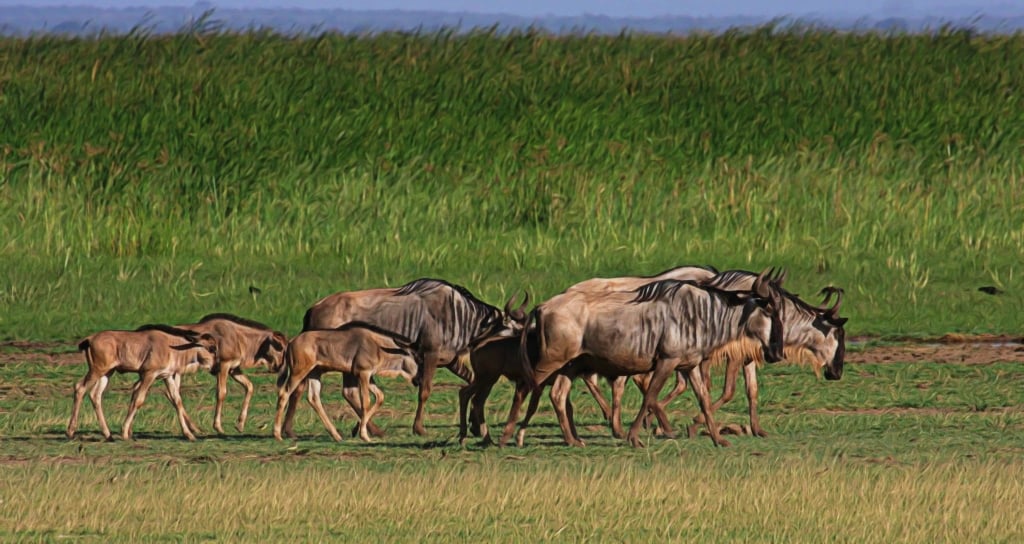- A new study published this week described in detail for the first time an endangered long-distance wildebeest migration in the Tarangire ecosystem of northern Tanzania.
- Wildlife migrations were once widespread globally, but are now mostly lost, and the remaining few migrations are in precipitous decline because of rapid, human-caused changes to the landscapes where they occur.
- The sustainability of the Tarangire wildebeest population is important to the ecological function and economic value of Tarangire National Park, one of the most profitable parks in a country where ecotourism is the #1 dollar earner and largest sector of the economy.
A new study was published this week describing an endangered long-distance wildebeest migration in the Tarangire ecosystem of northern Tanzania. In the study, wildlife scientists used machine learning and connectivity algorithms to delineate a previously undefined migratory corridor in order to save this vanishing natural phenomenon. Monica Bond, principal scientist at the Wild Nature Institute and co-author of the paper in Landscape Ecology said, “From a practical standpoint, we need better tools to understand how animals get from one place to another. Our work shows how data from multiple sources and the latest analytical techniques can be integrated to identify, connect, and protect an ecologically and economically important migratory corridor.”
A variety of different animal species undertake seasonal long-distance migrations, defined as round-trip movements between distinct areas not used at other times of the year. These journeys are made to avoid predators and severe weather, and to access resources in the place and time of highest quality. Consequently, migrations enable animal populations to grow far more numerous than non-migratory populations, with important effects on landscape structure and function. For example, in the famous Serengeti ecosystem in Tanzania, migratory wildebeest outnumber non-migratory wildebeest by nearly two orders of magnitude. Human hunter-gatherer societies around the world relied upon the superabundance of protein present in migratory species to support human population persistence for tens of thousands of years, and animal migrations likely played an important role in spreading people around the world after our emergence in Africa. Long-distance migrations also provide ecological benefits and services to the systems where they occur by transferring nutrients, fertilizing soil, and dispersing seeds. Until the 1800s, grassland ecosystems around the world continued to support vast herds of migratory hoofed mammals numbering in the millions of individuals, and these moving herds structured entire ecosystems. Unfortunately, migrations are now mostly lost, and the remaining few are in precipitous decline globally because of rapid, human-caused changes in the landscapes where they occur.
Human population growth and agricultural expansion have led to the loss of most historical migratory routes, including the elimination of all but three migrations of wildebeest. East Africa still supports a high diversity and abundance of migratory ungulates, but most of the remaining populations are threatened. Migratory populations often respond suddenly and severely to the disruption of migratory routes. At the end of the 19th century the Tarangire ecosystem’s wildebeest population likely numbered in the hundreds of thousands and connected with populations in southern Kenya. More recently, the Tarangire ecosystem’s wildebeest population decreased from an estimated 40,000 animals in 1988 to approximately 11,000 today. The Tarangire ecosystem’s eastern white-bearded wildebeest is genetically distinct from the much larger population of western white-bearded wildebeest in the Serengeti ecosystem, thus the loss of wildebeest in Tarangire would mean the loss of an evolutionary significant population. The sustainability of the Tarangire wildebeest population is important to the ecological function and economic value of Tarangire National Park, one of the most popular and profitable parks in a country where ecotourism is the largest sector of the economy.
“Given the growing demands on grazing lands in these migratory landscapes, there is an important need to accurately document core habitat used by migratory wildlife, and then provide this information to the policy makers who decide how land will be managed,” said Dr. Tom Morrison, of the University of Glasgow and co-author of the study. “Conserving migratory habitat for wildebeest will have the added benefits of protecting connectivity of rangelands used by Masai pastoralists and their livestock, and will benefit other wildlife species in this ecosystem, as they all use these habitats to move and graze.”
Reference:

